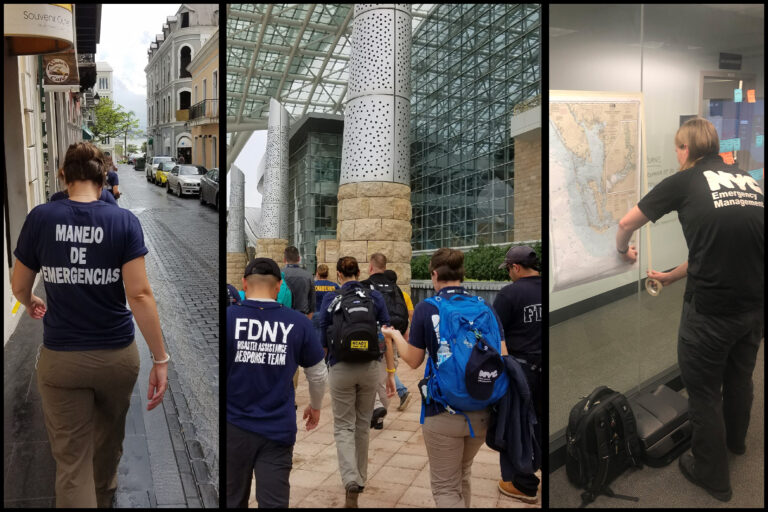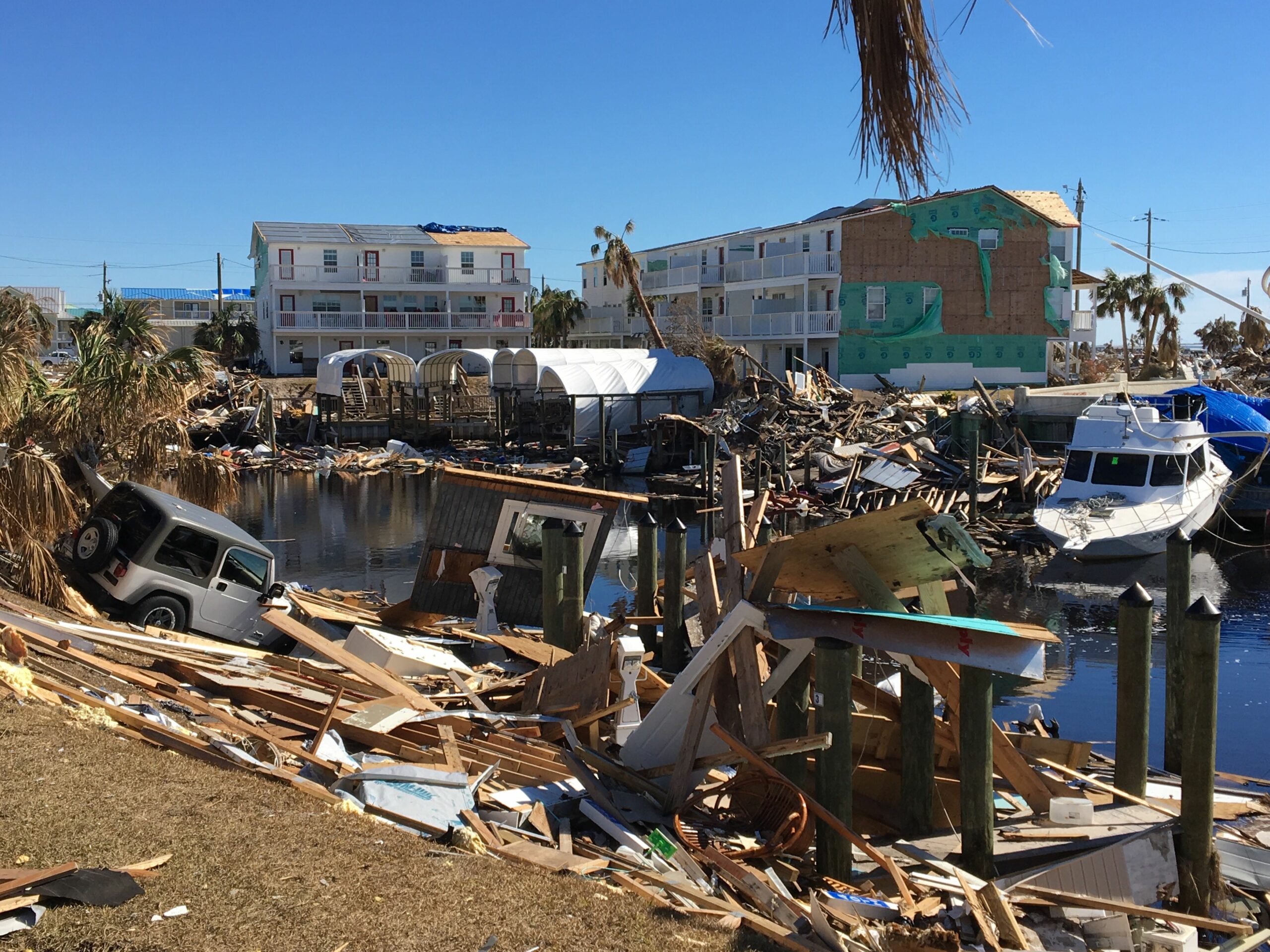After a disaster strikes, local resources can become quickly overwhelmed. When Puerto Rico suffered a 6.4-magnitude earthquake on January 6, 2020, most of the island was left without power. Buildings were damaged, roads and trees uprooted, and the aftershocks displaced many people from their homes. As a commonwealth of the United States, Puerto Rico qualified for an Emergency Management Assistance Compact (EMAC) after former Governor Wanda Vazquez declared a state of emergency.
Since the U.S. Congress ratified the EMAC in 1996, careers in the emergency management field have expanded as emergencies have changed and, in many areas, increased in frequency over the years. Whether responding to an earthquake in Puerto Rico, a building collapse in Florida, a tornado in Kentucky, or a wildfire in Oregon, the governor-led declared state-of-emergency responses and requests continue to foster relationships among states and improve best practices for future responses. EMAC is a mutual aid support from state to state that allows for personnel, equipment, and other resources during an emergency. Relationships built among cities, states, agencies, territories, and national organizations support the EMAC, which allows emergency management professionals to collaborate in different jurisdictions.
As emergencies have evolved, so have career opportunities in emergency management. Today, the field brings together people from many backgrounds and career paths. Some enter the field directly from college, some as a second career, and others have circumstances that lead them to this career over time. To demonstrate the diverse paths into the profession, three women from the New York City Emergency Management Department (NYCEM) shared the unique backgrounds that led them to this field.
Danielle Daly – Finding New Opportunities to Assist Other Jurisdictions
As a graduate student earning a degree in international development from the University of Birmingham in the United Kingdom, Danielle Daly thought she had her career planned out. That was until she took a class focusing on disasters in 2010.
By 2024, she held emergency management roles in the NYCEM, the American Red Cross Greater New York, and the New York State Division of Homeland Security & Emergency Services Office of Emergency Management. Daly is also Advance Team (A-Team) certified for the EMAC, a role that continues to strengthen her passion and open doors in the industry.
“EMAC is the national standard of mutual aid, and for me, it is at the heart of what we do as emergency managers. It allows us to help other jurisdictions, and at the same time, we learn from each other,” said Daly, who joined NYCEM in 2016 as a logistics program manager and is now director of mutual aid and request processing. As an industry veteran, Daly sees EMAC deployments as an opportunity to bring more women into the field at all levels of leadership, response, and recovery:
Emergency management has to be accepted as a profession of its own and not just as a second career for retirees or transfers from public safety agencies. This field is its very own career path. I’ve been doing this for 10 years, and you are seeing professionals like me more and more, where this is not a second career. We are some of the first in a growing wave of people doing this as a primary profession, and agencies need to be deliberate in their hiring and their opportunities. It needs to be more open to everyone.
At the Red Cross, Daly had deployed to North Carolina and the Adirondacks. With NYCEM, she was part of an EMAC assignment to Puerto Rico following the 2017 earthquake. She said the challenges of responding to a disaster became clear even before the plane landed. Once on the ground in Puerto Rico, she said the task of setting up the necessary systems to respond to the EMAC assignment intensified as the team faced issues with utilities and transportation:
Before departing from New York, the plan was for us to stay in a base camp initially, but we were moved to a hotel 90 minutes from San Juan right before we got on our flight. [NYCEM] staff eventually found a closer hotel for us, but that first drive out to the hotel was terrifying. There weren’t any lights or traffic signals of any kind. Debris was still in the roads – almost completely blocking them in some areas (we had to swerve around a tree on the highway at one point).
During the assignment, as an A-Team certified EMAC, Daly worked on processing EMAC requests – keeping teams informed on the status of requests, ensuring that the documentation was in place, and capturing details in operational meetings for potential requests. The experience reinforced Daly’s interest in the field and the importance of collaboration between different jurisdictions:
I mostly remember being stressed since I was helping support the EMAC response from both sides (helping the logs staff in [New York City] get the offers in order and processing as the receiver). To manage the intense emotions of the response, I focused on one problem, one doable task, resolved it, then moved on. Kept doing it until the day was over. Made a list for the next day and started again. Prioritizing the varying needs while also planning for the coming days and weeks put a real toll on the [Federal Emergency Management Agency] and [Puerto Rico Emergency Management Agency] staff that was there, especially as the [Puerto Rico Emergency Management Agency] staff were also dealing with the fact that their homes and families were affected by what had happened. At its core, EMAC is about jurisdictions helping jurisdictions, we definitely got to do that here.
Johanna Conroy – Fulfilling a Desire to Help People
When Johanna Conroy entered the emergency management field, she wanted to help people. While her initial professional goal was to assist people as an attorney, her career now spans over 20 years in various roles and agencies responding to emergencies. In 2005, Conroy joined NYCEM as a health and medical planner and is now the assistant commissioner for interagency coordination.
Before NYCEM, she was a volunteer coordinator with the Red Cross. In that role, she helped train and deploy volunteers. Moving from the Red Cross to the emergency management field, where fewer women have held leadership roles, Conroy made a name for herself:
The emergency management field is not as diverse as it should be, … but I was lucky to follow some great women who were blazing the trail. I had to overcome my fear of the unknown, and the only way to do that was to jump into the work and listen and learn. I felt a lot of imposter syndrome, but I slowly stopped being afraid and started taking the lead.
One of those challenging assignments was as part of an EMAC deployment to Florida in October 2018 to assist with the Hurricane Michael response and recovery. Conroy assisted with volunteer and donation management. She was eager to be part of an EMAC activation because of the great EMAC teams New York City received after Hurricane Sandy:
EMAC contracts are important because they allow the local emergency managers, who have been working the immediate weeks of the response, to take a step back to care for their own families who may have also been affected by the disaster. It allows people from other places who are subject matter experts to come in and assist with fresh eyes, new energy, and ideas for the operation. When it is your home city that is impacted, you are often dealing with grief, fear, and other tough emotions. Getting more people in to assist with the response is a great support, especially in locations that may not have a lot of depth in their emergency management departments.
Over the years, Conroy has seen many more women join the field. Emergency management has also broadened to require expertise in non-field response areas such as recovery and mitigation planning, external affairs, geographic information systems, public health, urban planning, and many more.
Natalie Grybauskas – Expanding Her Public Service Roles
Natalie Grybauskas is the assistant commissioner for response with NYCEM. Her career in public service and mayoral administration roles vary significantly: lifeguard, media research analyst, deputy press secretary, senior advisor for emergency management, and chief of operations, just to name a few.
In September 2022, the New York City Fire Department (FDNY) Incident Management Assistance Team deployed to Florida on an EMAC request to support recovery efforts from Hurricane Ian. When a second group deployed to Florida, Grybauskas went along as a trainee to shadow them. NYCEM has an incident management team program, and the FDNY incident management team has helped in a mentorship capacity since the beginning of the program. For Grybauskas, shadowing them during the initial part of that team’s deployment was helpful for understanding how EMAC requests work and what it looks like when an incident management team deploys on an EMAC. She also had an opportunity to work out of the state emergency operations center in Tallahassee, Florida:
NYCEM’s incident management team is an important program for the agency. We are much smaller than FDNY’s team, but our capability to respond to larger incidents within a contained geographic area is important to develop for our responses within NYC. One day, if the team continues to grow, we may be able to deploy on an EMAC request, but it will take a few years before we have enough qualified members.
Getting Involved in EMACs
For the NYCEM staff, being part of an EMAC assignment provided new career opportunities that expanded the reach of their day-to-day responsibilities. One of the founding cornerstones of emergency management is the spirit of collaboration. In their response plans, many cities, states, and territories are willing to share resources and staff outside their jurisdictions. Through EMAC assignments, states ensure that no jurisdiction has to respond to an emergency alone. For more information on EMAC, visit https://www.emacweb.org


Inés Bebea
Inés Bebea is the deputy press secretary for the New York City Emergency Management Department (NYCEM). NYCEM helps New Yorkers prepare, respond to, and recover from emergencies. Prior to joining the agency, Ines worked in a public information role with the Kings County District Attorney’s Office and held various reporting and editing positions with NBC, France 24, and The Network Journal. Ines was born and raised in Madrid, Spain.
- Inés Bebeahttps://www.domesticpreparedness.com/author/ines-bebea
- Inés Bebeahttps://www.domesticpreparedness.com/author/ines-bebea
- Inés Bebeahttps://www.domesticpreparedness.com/author/ines-bebea






